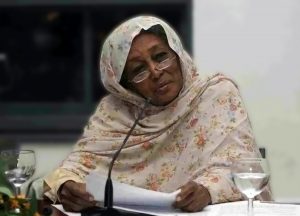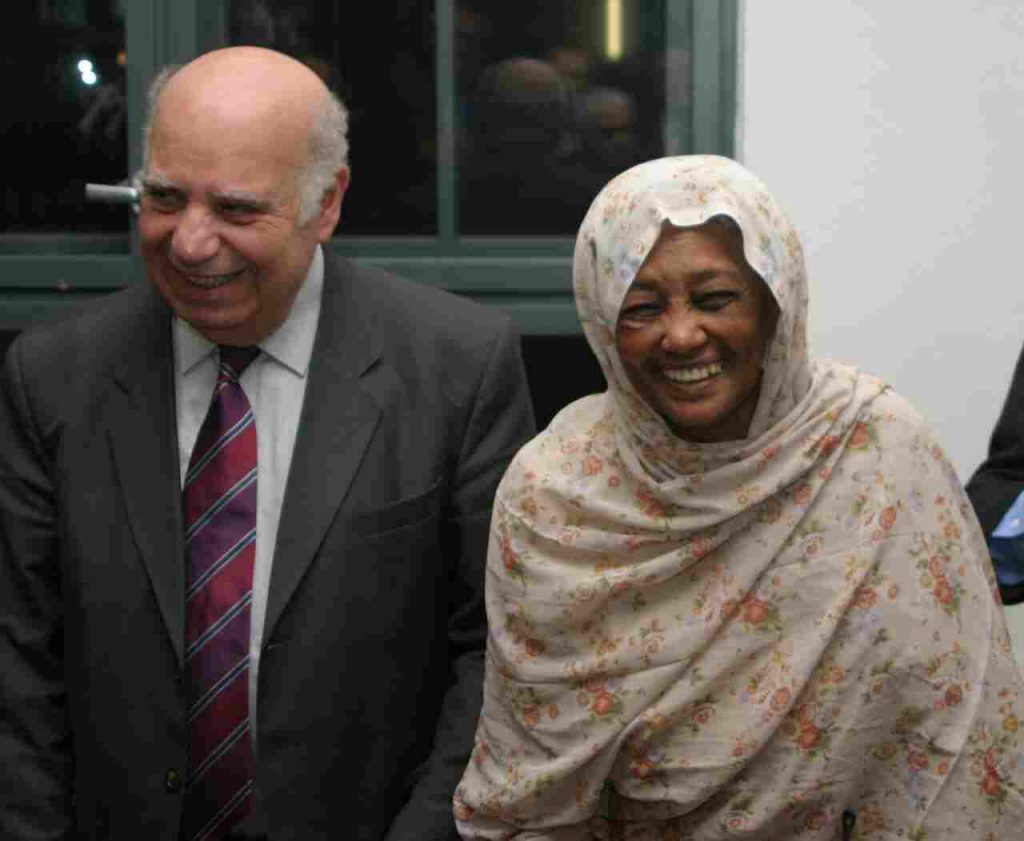“The good clouds of the Sudanese progressive women movement have all of them gathered around the valiance of Fatima Ahmad Ibrahim when, in her early youth, she walked along the most dangerous paths of progress: The liberation of the Sudanese women from the heavy grip of paternity in the 1950s. Fatima has, thus, lent women a voice very much loathed by people who considered that voice a fault, a shame”.

That is how Dr. Abdallah Ali Ibrahim sums up the great historical role shouldered by a Sudanese fighter in the defense of women’s rights, scoring successes unmatched in many of the World countries. Those successes still continue to shelter millions of Sudanese women.
Ibrahim, in his book titled: “Fatima Ahmad Ibrahim: A Beautiful World”, published in 2012, surveys the story of the struggle of this pioneer of women rights who, together, with her colleagues of the 1950s, built a monumental glory for the Sudanese women.
The author does not, however, deny the role of other Sudanese women, rank and file, in the building of this glory. He says: Fatima did not build this glory without much intelligence and good effort from countless women who cheered her when she foretold a new citizenship for women based on the fact that women are not victims, but fighters for a new humanity.
Dr. Ibrahim tackles Fatima’s achievements as leader of the Sudanese Women Union (launched in 1952) and its mouthpiece “Sout al-Mara’a (women’s voice)” magazine, that went into publication in July 1955. The author considers these developments the biggest social variables after the October 1964 revolution that toppled the country’s first military rule.” That revolution has triggered a political and social shockwave unprecedented and restored the denied rights of many sectors of the society. “
“If there is a social institution that endowed the October Revolution with its social gain, that should be the Sudanese Women Union. The Union’s strongest of forums in the call for social change was the Sout al-Mara’a magazine .
The magazine was very crafty as a journal when it married the concern with the issues of housewives (a majority at that time) with the defense of the rights of the then expanding working women sector.”
Then: What is the philosophy of this magazine that attracted audiences, no matter the varying ideologies?
We will detail this philosophy as because its approach is worth contemplation from similar movements:
The most outstanding aspect of the magazine is that it was devoid of the noise of ideology and its terminology, contrary to the situation in other platforms of the social progressive movement.
The magazine portrays women as it sees them in real life. That is a life the magazine does not look down upon thorough the preaching of a foreseen alternative life. As thus, the magazine topic headlines are extremely modest and caring about women: “women causes under the periscope”, “regional women”, “a photo roundup”, “with the working women”, “elegance and beauty”, “towards the light”, “the kitchen”, “the housewife”, etc…
For the magazine, women were not a subject of remote reform where it (the magazine) is just a spectator of a game. It (the magazine) is a basic player in that game. The magazine, in that sense, did not look down upon women or loathe them as the elite may do. It had a passion for the life of women as it was . It started, not by condemning that life as quite distant from modern life, but by thoroughly examining that life inside out. The magazine was free from such categorical rulings as: “This practice is wrong and should come to an end ..”
For instance, when the magazine wanted to study a certain aspect of women culture like the zar ( a spiritual dance), it did not heap curses on it and attribute it to backwardness. One magazine reporter, instead, assumes the role of an ethnographic researcher and personally attends one of these zar parties, takes part in it and then writes about what she had seen in a manner quite free from dogmatic rulings. The reporters did not preach a quick dumping of these practices. Instead, they organized interviews and on-scene visits. They listened to what the zar dancers say about the scope, dynamism and benefit of such practices.
The magazine had used to hold symposia at its premises and in the neighborhoods on women causes and problems. It was also keen to invite women specialists for these discussions, so rare as they were at the time.
The magazine, had strived, in earnest to back women’s rights in education, health, work , spouse choice and the other aspects where masculine domination had wronged women.
In the domain of education, the magazine in 1960 published a precise statistical study that showed the disparity in education chances between girls and boys. As a way out, the magazine proposed a two-fold plan to increase education opportunities for girls: The allowing of co-education in rural areas where the construction of two separate schools is unaffordable. The other plan was to permit girls into school at age 6 instead of 7. By so doing, the girl could get an adequate amount of education in case her family wanted her to terminate her education and get married.
Work-wise the women’s terms of service were unfair. A working woman earned 4/5 of a man’s salary and, further, women were allowed to work as typewriters only. In addition, once a working woman gets married, she was relegated from permanent service to a month-by-month service, thus depriving her from pension when she retired.
Upon a hectic campaign from the magazine and other activists, the government consented to the annulment of the month-by-month service wage for married women.
Before that, (in 1960) women obtained the right to get married on their own choice. Better than that, women obtained the right to vote and to run for elections after October Revolution in 1964, thanks to the effort of Fatima and her colleagues. Fatima Ahmed Ibrahim, consequently, became the first woman to be elected MP in the Middle East in 1965 and she continued to fight for women rights including the equal pay for both males and females (all of those rights became by the year 1969 part of the constitution). Fatima was elected in 1991chairwoman of the left-leaning International Democratic Women Union as the first Arab, African , Moslem woman to assume that post. In 1993, Fatima obtained the UN prize for human rights in recognition of her struggle for the rights of women and children.

